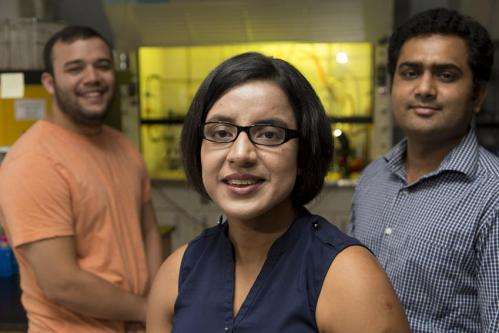Team uses nanoparticles to enhance chemotherapy

(Phys.org) —University of Georgia researchers have developed a new formulation of cisplatin, a common chemotherapy drug, that significantly increases the drug's ability to target and destroy cancerous cells.
Cisplatin may be used to treat a variety of cancers, but it is most commonly prescribed for cancer of the bladder, ovaries, cervix, testicles and lung. It is an effective drug, but many cancerous cells develop resistance to the treatment.
Shanta Dhar, assistant professor of chemistry in the UGA Franklin College of Arts and Sciences, and Rakesh Pathak, a postdoctoral researcher in Dhar's lab, constructed a modified version of cisplatin called Platin-M, which is designed to overcome this resistance by attacking mitochondria within cancerous cells. They published their findings recently in the Proceedings of the National Academy of Sciences.
"You can think of mitochondria as a kind of powerhouse for the cell, generating the energy it needs to grow and reproduce," said Dhar, a member of the UGA Cancer Center and principal investigator for the project. "This prodrug delivers cisplatin directly to the mitochondria in cancerous cells. Without that essential powerhouse, the cell cannot survive."
Sean Marrache, a graduate student in Dhar's lab, entrapped Platin-M in a specially designed nanoparticle 1,000 times finer than a human hair that seeks out the mitochondria and releases the drug. Once inside, Platin-M interferes with the mitochondria's DNA, triggering cell death.
Dhar's research team tested Platin-M on neuroblastoma-a cancer commonly diagnosed in children-that typically originates in the adrenal glands. In preliminary experiments using a cisplatin-resistant cell culture, Platin-M nanoparticles were 17 times more active than cisplatin alone.
"This technique could become a treatment for a number of cancers, but it may prove most useful for more aggressive forms of cancer that are resistant to current therapies," said Pathak.
Both Dhar and Pathak caution that their experimental results are preliminary and they must do more work before Platin-M enters any clinical trials. However, their early results in mouse models are promising, and they are currently developing safety trials in larger animals.
"Cisplatin is a well-studied chemotherapy, so we hope our unique formulation will enhance its efficacy," said Dhar, who is also a member of UGA's Nanoscale Science and Engineering Center, Center for Drug Discovery, and Regenerative Bioscience Center. "We are excited about these early results, which look very promising."
This work was supported by an award from the National Institutes of Health, grant number P30GM092378, through the UGA Center of Metalloenzyme Studies and the UGA Office of the Vice President for Research.
More information: Detouring of cisplatin to access mitochondrial genome for overcoming resistance, Proceedings of the National Academy of Sciences, www.pnas.org/cgi/doi/10.1073/pnas.1405244111
Journal information: Proceedings of the National Academy of Sciences
Provided by University of Georgia




















